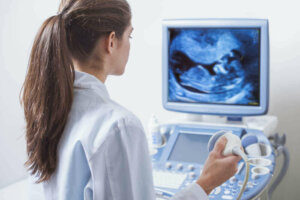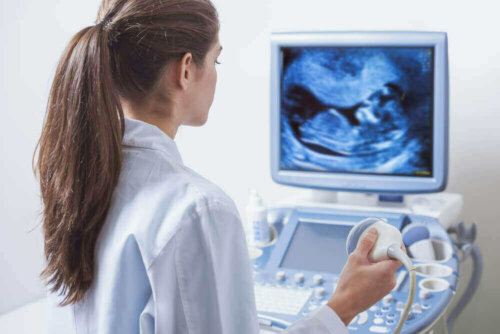Description and Causes of Late Term Miscarriage

Late-term miscarriage is one of those things pregnant women fear the most. It’s one of the main reasons they consult obstetricians during their first trimester. This is because there are many fears and misconceptions about the termination of a pregnancy.
Many women blame any negative behaviors they might’ve had. However, the reason has nothing to do with their behavior in most cases. We’ll explain a little more about late-term miscarriages below – it’s nothing to feel guilty or ashamed about.
What’s a late-term miscarriage?
A miscarriage or spontaneous abortion is the termination of a pregnancy, according to IntraMed, an online medical community. This term is commonly used in the first half of pregnancy when the fetus isn’t evolving. That is when the development of the embryo has completely slowed down and is no longer growing. This is a scenario in which a woman would need a late-term miscarriage.
These situations appear without associated symptoms and are more difficult for the parents to understand for this reason. It leads to states of uneasiness and doubts about fertility.
The attending doctor will perform a vaginal ultrasound in the first trimester to determine if a woman requires a late-term miscarriage. It may be necessary to repeat it before making a definitive diagnosis depending on the gestational stage.
The value in the chorionic gonadotropin hormone (a pregnancy hormone) begins to decrease about 10 days after the development of the embryo and stops completely. Thus, a blood or pregnancy test has no diagnostic value.
Symptoms of a late-term miscarriage
This condition is usually asymptomatic so women neither bleed nor have abdominal pain. It’s for this reason that the diagnosis is usually made late and doctors can only notice it after looking at an ultrasound.

You may be interested in: Types of Abortions You Should Know About
Causes of late-term miscarriage
Many women who’ve undergone a late-term miscarriage are afraid it’ll happen again.
The causes of late-term miscarriage lack symptoms that may promote expulsion or the bleeding that takes place to clean the uterus. That is there are no contractions, no dilation of the cervix, and no detachment.
However, what mainly raises doubts is knowing why the embryo stopped developing. You may not know it, but 15% of pregnancies end in miscarriage. Also, 80% of these occur during the first trimester.
The reasons why these types of miscarriages may occur could be:
- Genetic: Embryonic development is more delicate than you might think and the body tends not to allow the evolution of embryos with chromosomal malformations. According to this study published in Revista Chilena de Obstetricia y Ginecología, half of the miscarriages that occur during the first trimester are caused by chromosomal abnormalities. There are cases of milder affectations that can evolve and be carried to term but miscarriage is more common.
- The anatomy of the uterus: Malformations in the uterine structure that don’t allow the embryo to adhere properly. At least according to an article published in the Revista Médica de Costa Rica y Centroamérica.
- Endocrinological, blood, or immunological diseases. Usually, certain diseases that affect all the organs of the body have consequences during pregnancy. According to this publication in Reproducción magazine, between 8 and 12% of the cases of miscarriage may be due to some type of endocrinal alteration.
- Infections: There are some diseases caused by viruses or bacteria that harm the embryo and can lead to the type of fetal malformation that won’t survive.

Read also What Does An Ectopic Pregnancy Involve?
Recommended treatments
In these situations, it’s necessary to control the complete evacuation of all the contents inside the uterine cavity and examine the extracted tissue.
There are various processes to do so:
- Allowing the body to do the work. This consists of waiting for the body itself to expel the contents. It’s essential to carry out controls to assess the condition and monitor for infectious risks.
- Pharmacological treatment. Through the administration of vaginal medication that promotes the dilation of the cervix thanks to uterine contractions. According to a study, pharmacological treatment is a less aggressive alternative than surgery. Also, it has a 90% success rate.
- Surgical procedure. Doctors use curettage for this purpose, it either involves aspiration or a scraping technique. This surgical procedure requires anesthesia and a fasting period of about six hours before surgery.
We hope that this information about late-term miscarriage helps pregnant women face this challenging situation in the best possible way if they ever have to do so.
All cited sources were thoroughly reviewed by our team to ensure their quality, reliability, currency, and validity. The bibliography of this article was considered reliable and of academic or scientific accuracy.
- Jurkovic, D., Overton, C., & Bender-Atik, R. (2015). Aborto involuntario en el primer trimestre. IntraMed. https://www.intramed.net/contenidover.asp?contenidoid=80759&pagina=1
- Castillo Taucher, S., Fuentes Soto, A. M., Paulos Millanao, A., & de la Rosa Rebaza, E. (2014). Estudio cromosómico en abortos espontáneos. Revista chilena de obstetricia y ginecología, 79(1), 40-46. https://scielo.conicyt.cl/scielo.php?pid=S0717-75262014000100007&script=sci_arttext&tlng=e
- Matamoros, C. M., & Rodríguez, O. M. (2011). Una actualización en aborto recurrente. REVIStA MÉdICA dE COStA RICA Y CENtROAMÉRICA, 68(599), 423-433. https://www.medigraphic.com/pdfs/revmedcoscen/rmc-2011/rmc114h.pdf
- Ciarmatori, S. (2012). Aborto recurrente de causa endocrina. Reproducción, 27, 138-159. http://www.samer.org.ar/revista/numeros/2012/vol27_n3/revision_aborto_recurrente.pdf
- Montesdeoca, G. E., Pampalona, J. R., Grandal, T. G., García, E. R., Pruñonosa, J. C. M., & i Torras, P. B. (2014). Uso de misoprostol en el tratamiento de abortos diferidos del primer trimestre. Progresos de obstetricia y ginecología, 57(6), 243-246. https://www.sciencedirect.com/science/article/abs/pii/S0304501314001113
- Nivia, M. Á. A. (2007). El legrado uterino, indicaciones, beneficios y riesgos. Médicas uis, 20(2). https://revistas.uis.edu.co/index.php/revistamedicasuis/article/view/1837/2215
This text is provided for informational purposes only and does not replace consultation with a professional. If in doubt, consult your specialist.









